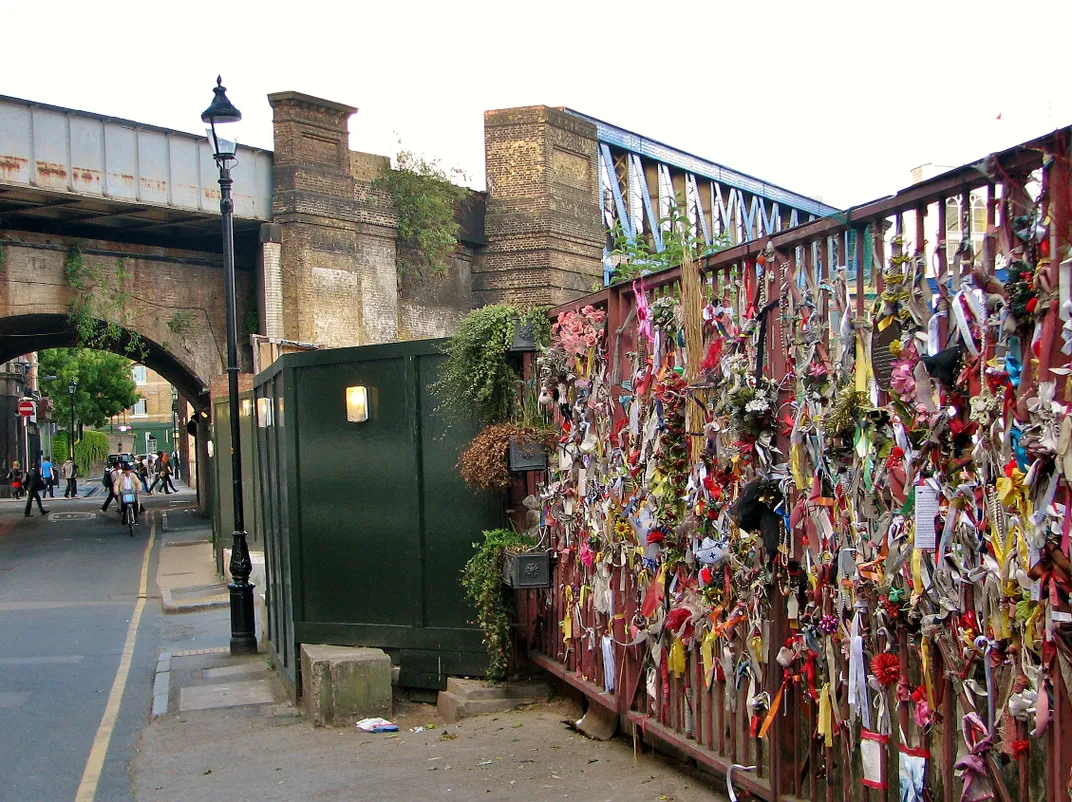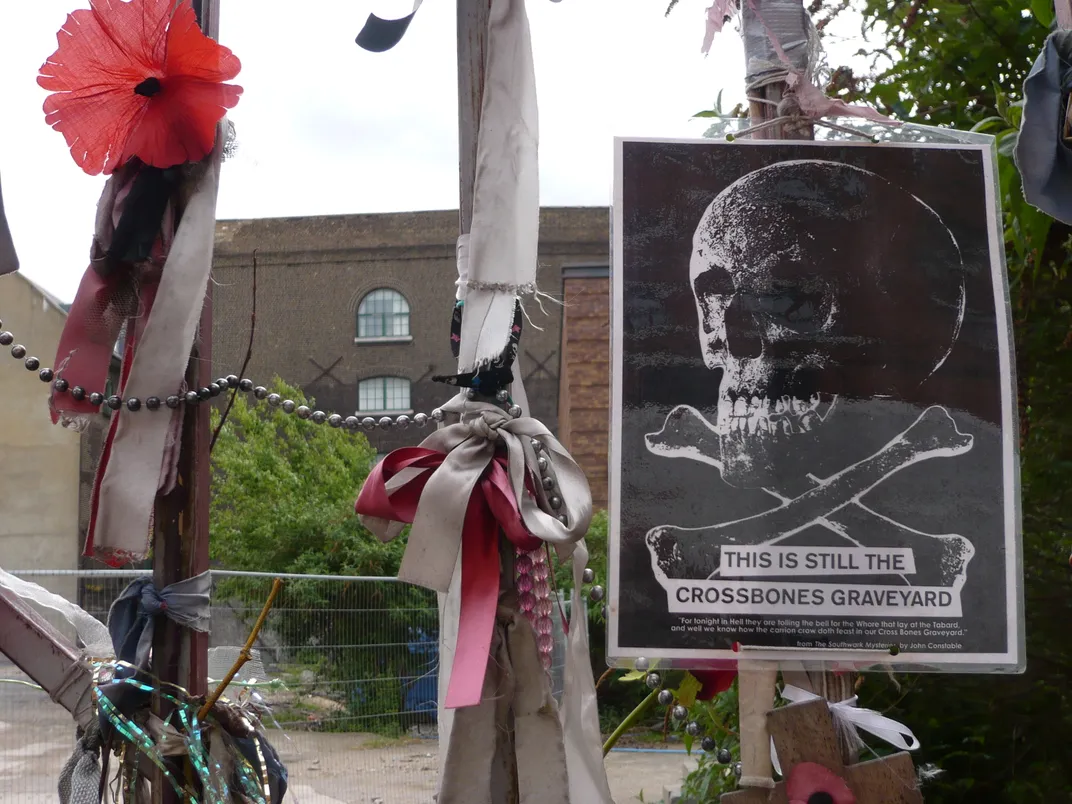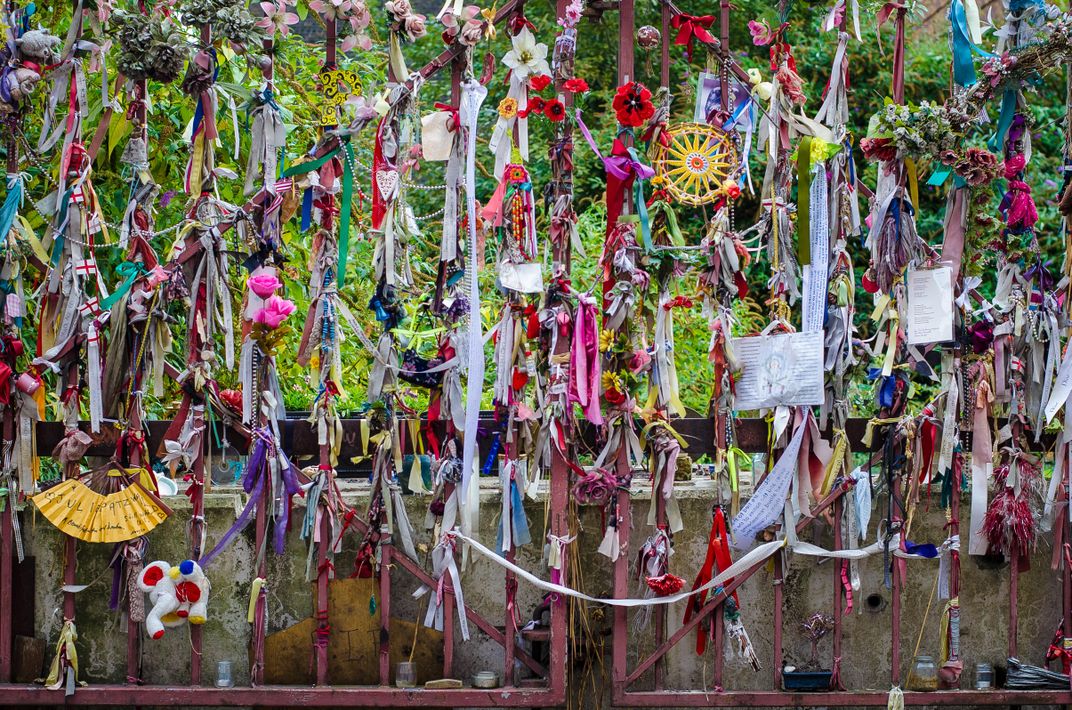The London Graveyard That’s Become a Memorial for the City’s Seedier Past
Thousands of bodies from London’s first red light district are buried beneath a lot in the South Bank, an area under massive redevelopment
/https://tf-cmsv2-smithsonianmag-media.s3.amazonaws.com/filer/55/3b/553ba646-415a-4fd5-b110-a34860544927/8686062698_6d4b6778c4_o.jpg)
London’s first red light district was on the south side of the River Thames, in the marshy, damp soils of the borough known as Southwark. There, in lands outside official London city limits, taverns, theaters, brothels and bear-baiting “amuseuments” flourished as popular forms of entertainment during the Medieval era. Today, the South Bank is known for gleaming office towers, and well-appointed cocktails bars and gastropubs, as tourists flock to the Tate Modern museum in a repurposed power station, take in Shakespeare at the Globe Theatre and admire the South Bank’s redevelopment. But the seamier side of Southwark history is recognized there too, in a small lot at the corner of Redcross Way.
Though rusted, the iron gates surrounding Cross Bones graveyard are festooned with ribbons, feathers, beads and other tokens commemorating those buried there. A plaque honoring “The Outcast Dead” was added in 2006, a more permanent version of a plaque said to have originally been placed on the gates by a group of Londoners in 1998. And every year since then, right around Halloween, these Southwark pilgrims re-enact a ritual drama to remember those whose final resting place is in Cross Bones, particularly the many prostitutes who are said to have been buried there during the Middle Ages.
Southwark’s association with prostitution goes back to the first century AD, when invading Roman soldiers used the area as a home base. Whorehouses operated in the area for centuries, through the Viking era and the Crusades, and became especially popular after the 12th-century construction of a permanent London Bridge brought a steady stream of commerce to the area’s taverns. By then, Southwark was controlled by the Bishop of Winchester, one of the oldest, richest and most important diocese in England. Among other powers, the Bishop had the right to license and tax the borough’s prostitutes, who were derisively known as “Winchester Geese,” perhaps after their custom of baring their white breasts to entice customers. To be “bitten by a Winchester Goose” was to contract a sexually transmitted disease, likely syphilis or gonorrhea.
Southwark’s brothels—which numbered between a handful and 18, depending on the year—were known as “the stews,” and survived for centuries despite repeated attempts from the royal throne to close them down. The crown also tried controlling the brothels through regulation: In 1161, Henry II laid down 39 rules known as the "Ordinances Touching the Government of the Stewholders in Southwark Under the Direction of the Bishop of Winchester." The rules made sure the prostitutes were able to come and go at will, required that all new workers were registered, restricted their activities on religious holidays, prevented nuns and married women from joining, banned cursing, and prohibited the women from taking their own lovers for free. The penalty for the latter included fines, prison time, a dip on the “cucking stool” into raw sewage, and banishment from Southwark.
Although the Bishop of Winchester regulated and taxed the area’s prostitutes, Christian doctrine prevented them from being buried in consecrated ground. The first likely reference to Cross Bones as a cemetery for Southwark’s “geese” comes from Tudor historian John Stow, who wrote in his 1598 Survey of London: “I have heard of ancient men, of good credit, report, that these single women were forbidden the rites of the church, so long as they continued that sinful life, and were excluded from Christian burial, if they were not reconciled before their death. And therefore there was a plot of ground called the Single Woman’s churchyard, appointed for them far from the parish church.”
“The stews” closed in the 17th century, and by the dawn of the Victorian era, Southwark was one of the worst slums in London, dense with crime and cholera, a place even policeman feared to tread. Cross Bones was repurposed into a pauper’s graveyard that served the parish of St. Saviour’s. In 1833, the antiquarian William Taylor wrote: “There is an unconsecrated burial ground known as the Cross Bones at the corner of Redcross Street, formerly called the Single Woman's burial ground, which is said to have been used for this purpose.” The area’s inhabitants led miserable lives, and suffered indignities even after death: Cross Bones was a favorite hunting ground for the bodysnatchers who unearthed corpses for use in anatomy classes at Southwark’s Guy's Hospital, among other places.
After the public complained that the overcrowded cemetery offended public health and decency, Cross Bones was closed in 1853 on the grounds that it was “completely overcharged with dead.” An 1832 letter from parish authorities had noted the ground was “so very full of coffins that it is necessary to bury within two feet of the surface,” and that “the effluviem is so very offensive that we fear the consequences may be very injurious to the surrounding neighborhood.” (At the time, people feared the city’s burgeoning population of foul-smelling corpses was partly responsible for the city’s cholera epidemic. The true culprit, the water supply, was discovered later.) The land was sold for development 30 years later, but the sale declared void under the Disused Burial Grounds Act of 1884. Locals resisted further attempts at development, although the land was briefly used as a fairground, until complaints about the showmen’s “steam organs and noisy music” became overwhelming.
The cemetery was more or less forgotten about until the 1990s, when the London Underground needed to build an electricity substation for the Jubilee Line extension on the site. Museum of London archeologists knew the land contained an old burial ground, and asked permission to excavate a small portion of the cemetery. They were given six weeks to complete the dig, in which they removed 148 skeletons from the top layers of the soil; by their estimate, less than one percent of the bodies packed beneath the ground. More than half of the skeletons the archeologists unearthed were from children, reflecting the high rates of infant mortality in that section of London during the 19th century, when Cross Bones served as a pauper’s cemetery. The scarred bones, encased in cheap coffins, showed that disease—including scurvy, syphilis and rickets—was rife. And the other 99 percent who remain underground? Their secrets will probably stay buried for generations more.
Meanwhile, author John Constable, a local poet and playwright, has begun his own work at Cross Bones. As Constable tells it, he was writing late one night in November, 1996, when he felt overtaken by a character he calls “The Goose,” the spirit of a medieval prostitute. She began dictating what would later become the first poem in Constable’s Southwark Mysteries:
For tonight in Hell
They are tolling the bell
For the Whore that lay at the Tabard,
And well we know
How the carrion crow
Doth feast in our Cross Bones Graveyard.
Constable says that later the same night, “the Goose” took him on a walk through the Southwark streets, whispering more poems, plays and songs in his ears, until the strange tour ended in a vacant lot. According to Constable, he didn’t know the lot contained Cross Bones until several years later. In fact, Constable insists that on that night in 1996, he had never heard of Cross Bones at all.
The verse Constable wrote down that night was later published as the Southwark Mysteries and has been performed at Shakespeare’s Globe Theatre and Southwark Cathedral, both not far from where the “stews” once stood. The Southwark Mysteries also formed the centerpiece of the first Halloween ritual at Cross Bones in 1998. For 13 years, until 2010, a growing community around Cross Bones performed parts of the Southwark Mysteries, created altars to lost loved ones, and joined in a candle-lit procession that ended at the cemetery gates. The ritual now takes place in a more simplified form, as part of monthly vigils at the site. The International Union of Sex Workers has even called for Cross Bones to be the first World Heritage site dedicated to those in the sex trade.
The modern rituals of remembrance at Cross Bones are complex, notes Patricia Dark, a Southwark historian and an archivist at Southwark Council. She notes that the identification of Cross Bones as a prostitute’s burial ground is more theory than proven fact, and rests primarily on Stow’s assertion in his Survey. And yet Cross Bones has become a potent site for remembrance because of more recent history, too. Southwark, once a vibrant riverside community filled with manufacturers, wharves, and warehouses, emptied out during the 1960s, when the rise of shipping containers greatly reduced the number of men necessary to work the docks. Redevelopment during the 1980s placed an emphasis on white collar business, leaving little room for the remnants of Southwark’s working class community. “The Borough now has lots of shiny steel office towers,” Dark says, “and lots of upscale places for an office worker to get lunch or socialize after work, but very little that would support actual community life on a day-to-day basis—it's all a bit soulless. … I think that Crossbones, by its very nature ... is a place where you can go and celebrate the people nobody remembers. I'd argue that the act of doing that helps the people doing the remembering feel like they matter too.”
In 2007, Transport for London, which now owns the site, gave Constable access inside the gates, where he and other volunteers have created a wild garden. Today, an informal group known as the Friends of Cross Bones is working to ensure that a planned redevelopment of the site preserves the garden as a more permanent place of reflection and remembrance. While no final lease agreement has been signed, the Southwark Council Community Project Bank has pledged £100,000 to create such a garden, and Transport for London planning guidelines have promised to be “sympathetic to its heritage.”
The community that has sprung up around Cross Bones is watching the developments closely. Monthly vigils to refresh the shrines at the site and honor the dead there continue, and several local homeless people have appointed themselves gatekeepers to keep desecration at bay. Constable has also developed a range of performances, workshops, and walks that continue to draw participants from London and beyond, many of whom choose to remember their own dead at the site. According to Constable, the rituals at Cross Bones are working to “heal the wound of history.” In some cases, they may also be a case of the community of today working to heal itself.




